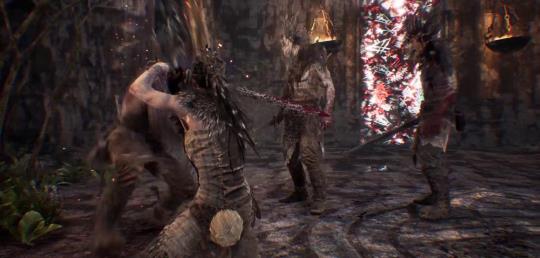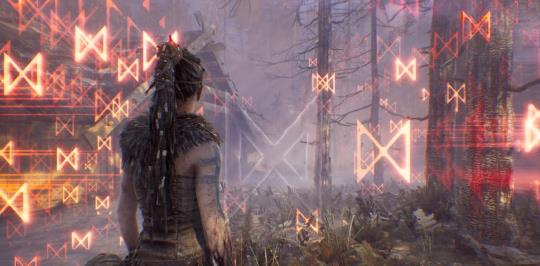Hellblade: Senua’s Sacrifice

When I think of a thirty dollar budget game, Earth Defense Force 2017 tends to come to mind. A completely unpolished and bizarre project whose absurdity and unique nature is often the source of its incredible fun. The B-Movie of video games, it’s lack of budget and cheap production is as much the charm and fun as it is in Bruce Campbell vs. the Army of Darkness.
Hellblade: Senua’s Sacrifice is a budget title, but it is not a video game equivalent to the cheap grindhouse shlock that would later inspire creatives like Robert Rodriguez, Guillermo Del Toro and Peter Jackson. It is much more comparable to a film like Reservoir Dogs. Clearly lower in budget and independently developed, but with greater technique and polish than its contemporaries. It may have its flaws, but its smaller scope – narratively and mechanically – do not keep it from standing alongside the more expensive and flashy AAA production content.
To understand what makes Hellblade work, it is first important to understand the real experiment developer Ninja Theory performed. Like many other action games, it is assumed that the bulk of the mechanics are found in the combat. Puzzles and labyrinths merely serve to break up and pace the action so as to not exhaust the player. Hellblade seems to follow just such a design throughout its first two zones, with puzzles and combat interchanging until the player must confront a boss.
Immediately following these zones the game takes away Senua’s weapon and spends a considerable amount of time without a single fight at all.

This is because the gameplay is not found in Senua’s blade, but in her mental illness. The combat is present because Senua is a warrior, but it is not the draw of Hellblade. Instead, each threshold Senua must cross explores a different type or manifestation of psychosis via gameplay mechanics. The most common is to discover runes hidden within the environment; an intersection of broken beams in a burnt down building that, from the right perspective, resemble a symbol. Perhaps a visual distortion in reality that, when examined from a different position, reveals a hidden bridge or stairway onward.
There are also unique puzzles as well, such as stepping through gateways that change the state of the world around Senua. Or perhaps lighting torches at the forks in an abandoned mine’s pathways, seeking the flicker of distant flame to indicate which illusory door will loop right back to the chamber’s entrance.
All the while the furies whisper in Senua’s ear. This is, perhaps, one of the most impressive aspects of the game. I was expecting the furies to only appear every so often, only speaking during key shifts in the narrative or upon examining essential portions of the environment. Instead, they are continually speaking, whingeing, screaming, and advising. There are very few moments where they provide something resembling silence, and while their speech can be repetitive, the sheer volume of unique exchanges and dialogue outside of combat is absolutely staggering.
Most of all, they are a sneaky way of delivering information to the player without having to break the tone. Never does the game prompt you to press a button to make something happen. Never is the fourth wall broken for the sake of “usability”. Nor do the furies ever tell the player to press a specific button on the controller to make something happen. The game trusts the player to experiment with button presses themselves, to make the effort to learn through trial and error. The closest to an instruction is when a fury informs the player to “focus”, an ability required to read lore stones, runes, and effectively improve their combat performance.
This makes the furies both a narrative device as well as a mechanical one. You could view them as an evolution of Na’vi from Ocarina of Time, warning the player when they’re outnumbered or helping to point out when there’s something notable in the immediate environment. The only real repetitive dialogue is found in the game’s sword fights, where the player is too busy concentrating on the action to really care about what the furies are saying. To those that do pay close attention, those often repeated warnings and cries will be recognized as feedback, alerting to sudden enemies striking from behind or of Senua’s current wounded status.

Using mental illness as gameplay allows Ninja Theory to deliver the narrative in a way uncommon to video games. When Senua is without her blade she is not given a new one by level’s end. She is not placed near a handful of enemies with simplistic A.I. so that she may spend a single level sneaking about. Senua must instead earn a new blade by facing a series of harsh truths, each designed and executed in a different fashion. Senua is still left feeling vulnerable even without the direct presence of familiar foes, but this vulnerability is put upon the player in separate ways.
It is not uncommon for a video game to replace an old blade with a new and better one, but in Hellblade it doesn’t feel like the player just got a +1 Sword of Glowing. Senua herself has been reforged and goes forth stronger. It is a step forward in her character arc, where her once shakey resolve becomes all the more adamant. Her journey is not yet over, of course, but it is her first step towards the final confrontation.
There is, I think, only one part of the game I did not truly enjoy. A shame, as the level’s beginning proves moody and atmospheric. Senua is left smothered in darkness, left to follow the sounds of the environment around her. From trickling water to the feel of the breeze to the sound of crickets in the night, Senua must use her senses to navigate the darkness. It’s a rather calm and serene trek until Senua steps into a cottage with a monster inside. Navigating the building with this formless monstrosity creeping about, pulsing and squelching with each step, delivers on the horror by keeping the atmosphere and tension in tact. The mechanics do not change. The player must still rely on their senses to avoid this beast and escape.
This is all shattered by the next and final segment of the journey. There are more of these beasts before the player, but they step across a linear path that must be followed to an end goal. Efforts to try and step around these creatures altogether is only met with failure. Instead, the player’s best option is to simply sprint forward, hoping they timed things right so as to avoid running head first into a beast.
This and the unreasonable hordes towards the game’s conclusion are about the only negative criticisms I can level at Hellblade: Senua’s Sacrifice. It is an experimental game that will stick with me for a long time, and will no doubt beg to be replayed. It not only has heart, but it has a craftsman’s attention to detail and an artist’s sense of aesthetic and atmosphere.
Ninja Theory was right in their many developer diaries. This is a project that would not have been allowed by a traditional publisher. It was a risk tackling such an ambitious game on the studio’s own cash reserves, but I do hope it will pay off. I would love to see other studios with great talent allow smaller teams to create games that straddle the line between indie and AAA. There needs to be that middle-ground where ambition can meet the resources to achieve such a vision.


